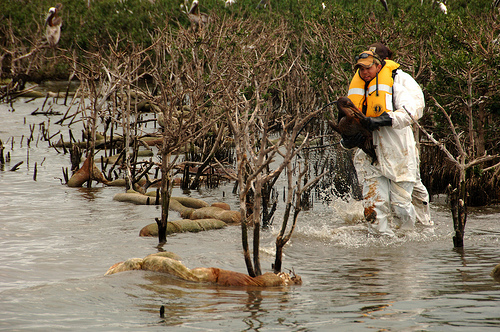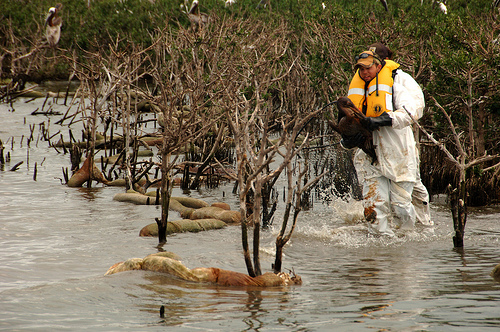 A U.S. Fish and Wildlife Service worker carries an oiled pelican to a boat for transport to a recovery center.Photo: Deepwater Horizon ResponseCoast Guard Admiral Thad Allen, Barack Obama’s talking head of choice, made news on the Sunday talk shows with his grim prediction that the battle against BP’s oil blobs will last well into the fall.
A U.S. Fish and Wildlife Service worker carries an oiled pelican to a boat for transport to a recovery center.Photo: Deepwater Horizon ResponseCoast Guard Admiral Thad Allen, Barack Obama’s talking head of choice, made news on the Sunday talk shows with his grim prediction that the battle against BP’s oil blobs will last well into the fall.
But scientists know that we’re actually in for a much longer haul, and right now they have a lot more questions than answers. Here are four things scientists wish they knew:
1. What effect are dispersants having on life deep under the sea?
Would you like a little toxin with your oil? BP has now dumped almost a million gallons of dispersant into the Gulf, but other than that, as a scientist told NPR, no one really has a strategy for cleaning up the water beneath the surface. As Melanie Warner, writing for BNet, notes:
[T]he problem with chemicals like Corexit, outside the fact that they are inherently toxic, is that they don’t actually get rid of the oil — they just spread it around. The result is that oil that normally would float on the surface now seeps deeper into the water where its various components, many of them toxic, become available to not only fish but the tiny plants and organisms that fish and other marine animals eat. In other words, the oil — and human carcinogens like napthalenes, benzene, toluene, and xylenes — enter the food chain.
Or as LSU professor Ed Overton told the New Orleans Times-Picayune last month:
[W]e know almost nothing about what happens down in that area of the environment. If we know there’s a million fish swimming near the surface and 100,000 of them die (from the oil and the dispersant), that’s 10 percent of the population lost. But if there’s only 10 fish down in the deep water — and all we really know is that there are far fewer creatures — and all of them die, that’s 100 percent.
2. Will the spill create more dead zones in the Gulf?
Spawn of the dead: Every spring, the Mississippi River dumps fertilizers from Midwest farms into the Gulf, and that creates a huge dead zone when plankton and algae bloom and then decay on the ocean bottom, draining oxygen out of the sea water. No one is quite sure if all the oil and dispersants floating around the Gulf will suck life out of more sections of the sea. Scientific American‘s David Biello wrestles with the maybe-yes-maybe-no issue:
Regardless of what may happen near shore, the deeper waters of the Gulf — where the oil is directly spilling — may form their own dead zones, thanks to the busy work of microorganisms breaking down the oil and consuming oxygen in the process.
3. Which species are most at risk?
Sorry, Charlie: Again scientists can only speculate, but it’s not looking good for sea turtles or bluefin tuna.
Sharon Begley, writing for Newsweek, says a deepwater spill like this is likely to hammer all kinds of species.
Leatherback turtles and sperm whales dive to the 3,200-foot depths where plumes have now been detected, and aren’t smart enough to take evasive action. … Sharks, shrimp, and squid are all inhabitants of the deep, which would protect them from a Valdez-type spill on the surface, but now puts them in the crosshairs. Marlin, snapper, and grouper swim hundreds of feet down.
And who knows what will happen to the stranger habitats of the deep. The Houston Chronicle‘s Shannon Tompkins ponders the fate of a particularly accommodating algae known as sargassum:
Sargassum, a floating algae that forms large mats on the ocean’s surface, provides crucial habitat for scores of species in the Gulf. Scientists have documented at least 140 species of fish using sargassum, and it is vital habitat for juvenile blue marlin as well as most fish, crabs, and other animals of the open ocean. Sargassum mats are feeding grounds for larger marine species, including sea turtles. That sargassum and all the creatures living in its “leaves” are particularly vulnerable to oil on the surface.
4. How long will our long national nightmare go on?
The kill that keeps on killing: If scientists learned anything from the Exxon Valdez spill, it’s that oil can poison an environment for decades. By 2003, 14 years after the tanker crashed, 21,000 gallons of oil were still in Prince William Sound. And, as The Washington Post‘s Joel Achenbach and David Brown point out, an oil spill is one nasty serial killer.
The Exxon Valdez spill of 11 million gallons killed as many as 700,000 sea birds and 5,000 sea otters initially, but even 21 years later, populations of sea otters in areas of Prince William Sound haven’t recovered. The Pacific herring population collapsed after the spill for reasons that remain in dispute among scientists. Two intensely studied pods of killer whales in the sound suffered heavy losses in the spill and have struggled since. One of the two pods has no more reproductive females. It is doomed to extinction.
Maybe ignorance is bliss.



